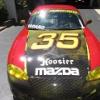I'll chime in here. Disclaimer: I've never seen a whistler and have no idea how they're used. I also have never cc'd an engine. But I've been in aerospace manufacturing for a few years and have worked in metrology (measuring stuff). Even in ISO certified aerospace manufacturing processes it is common to have a specification limit defined but the verification method is left up to the manufacturer. Findings will absolutely vary based on method of inspection. For instance if you inspect a cylinder bore use a 2 point dial bore gage versus an air gage versus a CMM you WILL get different readings. There is far more gray in the interpretation of the finding than most non technical people would ever expect. I've had to contest rejections based on misuse of inspection tools and variation between inspection methods many times.
If Ti Speed or anyone else has actually used the whistler to verify compression because that's what SCCA is using than in a ISO quality philosophy they have done nothing wrong. The correct approach here should be for the SCCA to define exactly what method they approve to verify compression and that's the standard Period. If another method of inspection shows different reading then so be it. The approved method is the only one that counts. What would you do if during a tear down inspection the cam diameters were inspected with a caliper rather than a micrometer and failed because it was out .002"? I suspect most folks would challenge the findings and they should.
Although we certainly have seen intentional cheated stuff, I'm not convinced this is one of them. IMO the solution here needs to be a proper definition by the SCCA and NASA on how exactly the compression limit will be tested. The tools and procedure need to be documented and verifiable between various techs and witnessed by racers in question. Define the process, verify, and document. Problem solved. Now let's move onto driver parity...




 Sign In
Sign In Create Account
Create Account





 Back to top
Back to top Report
Report

























